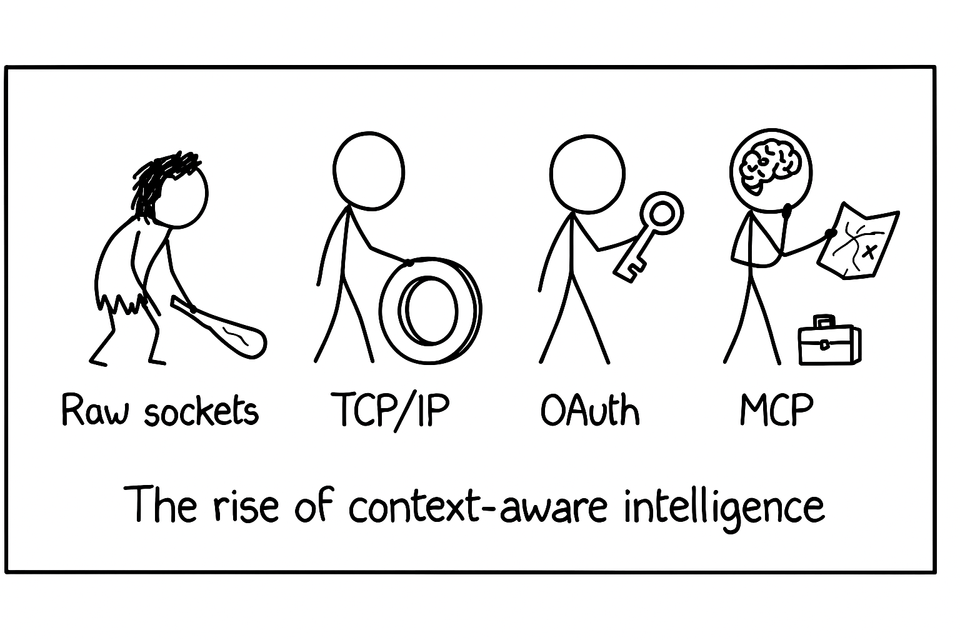MCP + APIs: Future of Intelligent Integrations

In the age of intelligent software and conversational AI, the bridge between large language models and real-world applications is no longer just about API calls—it's about context.
As businesses increasingly deploy AI across vertical SaaS, fintech, healthcare, and enterprise workflows, understanding how models interpret context and how APIs deliver it, is mission-critical.
I explored how MCP servers are transforming the way AI systems integrate with APIs, and why this matters more than ever for developers, architects, and product leaders building the next wave of smart applications.
What Is a Model Context Protocol?
At its core, a Model Context Protocol is a structured way to inform a model about its role, environment, goals, and the tools (like APIs) at its disposal. I'd like to think of it as the meta-layer of communication—telling a model what it’s doing, why it’s doing it, and how it should act.
Instead of simply sending prompts and awaiting responses, MCPs enable persistent, role-based, and tool-aware interactions, where the model isn’t just reacting—it’s reasoning in context.
Why Now?
Most of us have started using autonomous agents, multi-modal models, and domain-specific AI applications, the demand for context-rich, dynamic behaviour has skyrocketed , if not now, it soon will. Static prompts can no longer enough and enterprises want models that can:
- Access live data through APIs
- Maintain awareness across sessions
- Act differently depending on the user, goal, or vertical
Model Context Protocols make this possible.
MCP + APIs: A Match Made for Modern AI
APIs are the veins of software—delivering data, triggering actions, connecting systems. But models need to know what APIs exist, when to call them, and how to interpret the responses.
This is where Model Context Protocol comes in.
Key Components of MCP + API Integration:
- Tool Description Layer
Define the APIs a model can access, including:- Function names
- Input/output schemas
- Authentication flows
- Usage constraints
- Contextual Memory Layer
With MCP, the model maintains:- User roles and permissions
- Previous interactions
- API usage history
This allows smarter decisions and fewer errors.
- Dynamic API Calling
Once the protocol is established, the model can autonomously call APIs within its allowed scope, making real-time decisions without hard-coded logic.
Intent-to-API Mapping
MCP helps the model infer when an API should be used based on user input. For example:
“What’s the current balance in my business account?”
⟶ MCP maps this to thegetAccountBalance()API.
Real-World Applications
Here’s how MCP + APIs are reshaping industries:
- Fintech: Chat-based financial assistants that know your portfolio, understand KYC protocols, and execute trades via integrated APIs. (Coming Soon.. More on this next week)
- Healthcare: AI models accessing EMR systems to fetch patient data, interpret lab reports, and assist in diagnostics—safely and in context. (Coming Soon.. More on this next week)
- Customer Support: Agents that pull live order status, issue refunds, or escalate tickets—all while maintaining conversation continuity.
This is not just automation. It’s contextual cognition at scale.
Attention : Developers and Product Leaders
As AI continues its platform shift, teams building agentic workflows and smart copilots will need more than just model access—they’ll need a protocol-driven foundation for managing context and tool usage.
Model Context Protocols will be to AI what REST and GraphQL were to the web.
They will define how models interact with the digital world—safely, intelligently, and efficiently.
For forward-thinking developers and architects, now is the time to:
✅ Design your internal API schema with AI-readiness in mind
✅ Start documenting API functions in model-consumable formats (e.g., OpenAPI, JSON schemas)
✅ Explore open standards like LangChain’s tool schema or OpenAI’s function calling
✅ Think beyond prompts—design protocols for your models
🔁 If this sparked ideas or gave you a fresh lens, feel free to like, comment, or share it with your network.

Member discussion